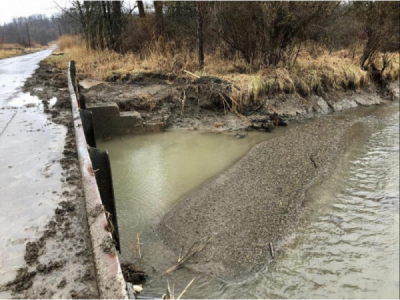
Posted on March 4, 2020
The U.S. Army Corps of Engineers Buffalo District recently completed most of the Stanford Run ecosystem restoration project within Cuyahoga Valley National Park.
The Buffalo District restored nearly 1,200 feet of Stanford Run, a small stream within the national park, under the original Stanford Run restoration project contract awarded to Ryba Marine Construction Co. The district also awarded a second follow-on contract to Armitage Architecture, P.C. in September to continue work on the channel, which restored an additional 1,000 lineal feet.
“Primary work specified in the contract is complete, but minor work such as additional grading and seeding at the disposal area will resume in the spring,” USACE Buffalo District project manager Russell Brandenburg said in a news release.
Stanford Run became degraded when sediments built up in the floodplain and blocked a stone culvert under the Ohio & Erie Canal Towpath Trail. Eventually, the stream channel filled in upstream of the blockage, which backed up sediments in another culvert under Stanford Road in northern Summit County. The blocked culvert at Stanford Road diverted flow north into an adjacent watershed, where it caused massive erosion and habitat degradation.
Ryba Marine Construction installed a new box culvert under the Towpath Trail that is sized to accommodate present-day storm flows and restored a major portion of the stream. Native trees and shrubs also were planted along the stream banks.
Armitage Architecture continued stream restoration and removed sediment from the blocked culvert under Stanford Road, allowing stream flow to return to the channel. Restoring Stanford Run to its historic alignment should allow natural processes to take over.
Funding for the restoration work, which is the largest habitat restoration project completed so far at Cuyahoga Valley National Park, was provided over two years through the Great Lakes Restoration Initiative.
“We’re already seeing fish swimming in the restored creek and beavers working upstream of the restoration area,” CVNP biologist Chris Davis said in the news release. “Sand and gravel in the bottom of the creek, as well as streamside vegetation, will provide structure and shade to support insects and other in-stream creatures. Overall, the project looks like a success so far.”
Source: beaconjournal.com





